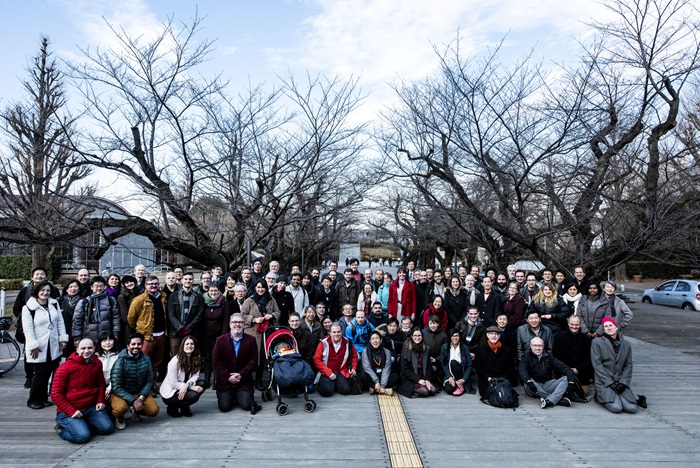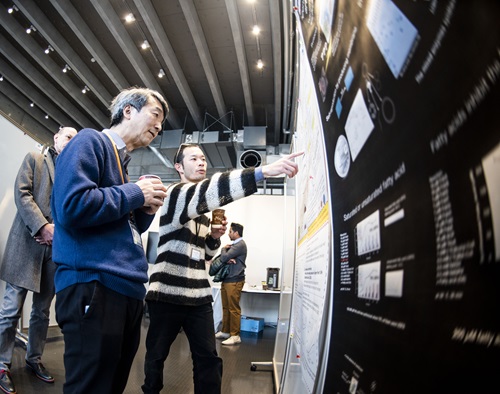Blog No.148
Author: Marc Kaufman

The concept of emergence has been with us since at least the time of the Greeks. The process by which simple components become more complex and produce novel, often surprising systems that are greater than the sum of their parts, emergence has waxed and waned in scientific influence.
In recent years, thinking about emergence has become increasingly important in a variety of disciplines. It can be as simple as the combining of oxygen and hydrogen to form water, as vast as the cosmic march from the Big Bang to rise of humans, and as endlessly complex as the origins of life on Earth.
Intrigued by the power of emergence to help research and understand many of its central goals, the leaders of the Earth-Life Science Institute at the Tokyo Institute of Technology constructed their yearly symposium as an exploration of the topic.
Speakers included astrophysicists and organic chemists, philosophers and practitioners of artificial life -- in which scientists simulate natural processes with computer models, robotics and biochemistry. The gathering spanned four days in January and brought more than 100 scientists to the campus.
While it was a familiar kind of conference in that experts in their fields gave talks about their work, something else was going on.
By design, the "Comparative Emergence" meeting was also a social experiment - an effort to, in effect, test whether a kind of intellectual emergence could and would emerge during the conference.
"We purposefully arranged the talks so there would be some confusion, some difficulty in understanding the concepts of emergence," said John Hernlund, an ELSI principal investigator and head of the science organizing committee. "And clearly there was."
"But we didn't bring people here to tell them what emergence is," he said. "We wanted to create an environment where they could discover it for themselves, and hopefully see it in a broader context than in the past."

Not knowing that the meeting had this added dimension, some of the scientists chaffed at seemingly confusing decisions about how the gathering progressed. But by the end, when some of the more philosophical and encompassing aspects of emergence were presented, a broadly-shared view seemed to develop that something worthwhile had taken place.
That came out in exit surveys that showed large majorities of participants reporting that they had new understandings of emergence in their own and other fields, that they met people with whom they were likely to collaborate with, and that the symposium helped expand their ability to understand the connections between their own and other research fields.
Given the decision to organize the symposium as something of a social experiment --as well as a gathering place for new understandings and connections -- there were also negative reactions to the program. Some described the presentations as confusing and regretted that the broad philosophical aspects of emergence had been described at the beginning rather than the end.
What was apparent, though, was that the scientists were exposed to the concept of emergence in innumerable fields. The goal, Hernlund said, was to present emergence as a tool for approaching many problems, and one that would stick with people and resonate when the time was ripe.
As described by attendee Luis Campos, a historian of science at the University of Mexico, the concept of "emergence" has been with humans for centuries and in the 19th and early 20th centuries became a formal and powerful part of scientific discussion. Much of that discussion of emergence revolved around the question of how life began, but it went beyond that and was especially strong in philosophy.
The days of that early flowering of emergent thinking were cut short by the growth and gradual triumph of reductionism - the proposition that scientific experimentation and theory can thoroughly explain characteristics and processes by breaking them down to their component parts. The gaps that emergence was proposed to fill became seen as gaps in understanding rather than inherent and distinct processes that were themselves part of nature.
But especially with input from the worlds of complexity science and artificial life, emergence has come back. Some examples put forward during the week included the swarming of birds and the dynamic intricacies of ant colonies, the self-organizing of a hurricane, how billions of brain neurons work together to create consciousness, how convection arises. And there's the liquidity that comes from the H20 bond.
But emergence as presented at the symposium went well beyond.
There were sessions on the emergence of the universe (how the quantum turbulence that followed the Big Bang evolved into a web of galaxies, stars, planets;) emergence in planet formation (how planets with very different characteristics and chemistries came to be;) emergence in the onset of life (or of potentially many proto-lifeforms that either went extinct or were in the lineage of the Last Universal Common Ancestor or LUCA;) emergence in chemical complexity (simple molecules to complex ones able to encode information) and emergence in social systems (with models of how residential segregation evolves or traffic jams pop up.)
All involve processes that went from simple to complex and novel, and all involve self-organization by the emerging complex trait, process or phenomena.

Yet in keeping with the social experiment aspect of the symposium, many of the talks barely mentioned emergence, or did so in passing.
The presentation of Katie Mack of the North Carolina State University, for instance, elegantly described the evolution of the universe from nothing to something grand, yet she didn't use the word emergence at all. (She told me after the talk that emergence plays little or no role in her field, although cosmology is overflowing with phenomena others call emergent. Her view changed a bit by the end of the symposium.)
Yasuhito Sekine, a professor at ELSI in planetary science and astrobiology, went deeply into the quite different chemical compositions of the subsurface ocean of the moons Enceladeus and Europa.
He told the story as a boxing match between the two moons to see which is more likely to be habitable. He traced back the reasons why the water of Enceledeus is alkaline and contains organics and chemicals associated with life, while Europa has water that is more acidic and contains a very different collection of chemicals. But Europa, he argued, has a very different - and more favorable - energy regime.
His history of how the oceans evolved so differently would appear to involve what others at the symposium would consider emergent properties, but he too did not use the word "emergence." (The habitability contest, he concluded, ended in a draw.)
One early speaker who did directly address emergence was Takashi Ikegami, a professor at the University of Tokyo and a specialist in the field of artificial life (ALife). From his perspective, emergence involves the ability to constantly produce novelty in an open-ended evolution, with self-organization as a central theme.
ALife has been in the forefront of modern thinking about emergence, although its definitions and experiments are highly abstracted and not always adaptable to some other fields. And while Ikegami is an acknowledged global expert in the ALife, he is also entirely comfortable in acknowledging the limits and challenges of his field and of his own understandings.

It was only really on the last day that speakers broadly addressed emergence head-on. The concept had been discussed, debated and defined in breakout sessions from the first day, but the symposium speakers had generally described what might be called emergent phenomena in their own fields without diving into emergence itself.
Philosopher Paul Humphreys of the University of Virginia made the case that emergence exists in numerous forms, with some far more meaningful than others. He said a significant percentage of what is now called emergence involves gaps in understanding, with nature concealing its workings so well that scientists cannot understand what is happening.
More interesting, he said, are examples of emergence where there likely is no explanation available. In the worlds of quantum and particle physics, for instance, emergences occur that defy the known laws of nature and physics.
The formal symposium ended with a talk by Francis Heylighen, a complexity specialist from the Vrije Universiteit, Brussel. He said that he had planned to present his talk in a pedagogical context, but that after four days in Tokyo he realized it would be more on the provocative side.
That, he said, is because the scientists had been largely trained in traditional mechanistic, Newtonian science, with the goal of reducing phenomenon to component parts. As a result, he said, emergence was seen by some as an illusion or as mysterious. But his view - as expressed in the title of his talk - was: Why Emergence is Simple, Common and Natural?
His talk took the symposium through a seemingly simple yet powerful description of why "wholes" have different characteristics than "parts." Wholes, he said, have different "input" and "output" networks than parts have, and they emerge through their own rules of self-organization of parts.
Nothing illusory or magical, he said. Just how phenomena all around us work.
Asked if there was a minimum number of components needed to form an emergent system, he gave this example of what he called a complex emergence: Two people get married. It could be a good marriage or a bad marriage, but the marriage itself has properties different from those of either of the two individuals.
Something novel has emerged.
Photo credit: N. Escanlar/ELSI
